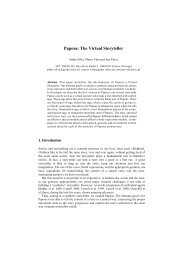Are we telling the same story? Balancing real and ... - ResearchGate
Are we telling the same story? Balancing real and ... - ResearchGate
Are we telling the same story? Balancing real and ... - ResearchGate
- No tags were found...
Create successful ePaper yourself
Turn your PDF publications into a flip-book with our unique Google optimized e-Paper software.
Figure 11 – Change in <strong>the</strong> Princess’s relationConclusionsThis paper argues that, to achieve interactivity ininteractive narrative systems, <strong>we</strong> can regard <strong>the</strong> <strong>story</strong>construction as a collaborative process bet<strong>we</strong>en users <strong>and</strong>characters. Ho<strong>we</strong>ver, for that to be possible, <strong>the</strong> charactersneed to have a role <strong>and</strong> be autonomous enough to decidewhat to do at a certain instant. In <strong>the</strong> paper, <strong>we</strong> havedescribed <strong>the</strong> construction of such type of autonomousagents using an emotional architecture based on FATiMa.This development was done in <strong>the</strong> context of <strong>the</strong> I-Shadows system, an interactive drama where <strong>the</strong> user isfree to act in <strong>the</strong> physical world by manipulating shadowpuppets.The stories created are a result of <strong>the</strong> actions of <strong>the</strong> user<strong>and</strong> <strong>the</strong> actions of autonomous characters. Fur<strong>the</strong>rmore,supported by <strong>the</strong>oretical groundings in interactive drama<strong>and</strong> <strong>the</strong> role that <strong>the</strong> proposed emotional model has inachieving interactivity, <strong>we</strong> have built a Director agent thatsomehow coordinates parts of this process (based on thatemotional model).Authoring characters using FATiMa is not easy due to <strong>the</strong>lack of a <strong>real</strong> methodical authoring approach for buildingagents for interactive narrative. A character-centredapproach needs to be follo<strong>we</strong>d, <strong>and</strong> that is often difficult todo. Characters are acting according to <strong>the</strong>ir roles <strong>and</strong> havedynamic relations, <strong>and</strong> it is <strong>the</strong>se roles <strong>and</strong> relations thatneed to be captured in <strong>the</strong> agents’ minds. Although <strong>the</strong>results are so far positive, <strong>we</strong> believe ho<strong>we</strong>ver that, to<strong>real</strong>ly obtain a good play, <strong>the</strong> characters need to be fur<strong>the</strong>rimproved. Moreover, <strong>we</strong> expect to start evaluating <strong>the</strong>system with children very soon <strong>and</strong> evaluate <strong>the</strong> degree ofcollaboration achieved bet<strong>we</strong>en <strong>the</strong> children <strong>and</strong> <strong>the</strong>system.Figure 12 – Hero’s emotional stateFigure 12 shows <strong>the</strong> actual hero’s emotional state afterfailing to defend a Victim. The hero was in a very positivemood because of <strong>the</strong> joy he felt when <strong>the</strong> victim expressedher love for him. Suddenly <strong>the</strong> villain hits <strong>the</strong> victim. Thehero appraised this event as a very negative action, <strong>and</strong> feltdisappointed, this appraisal generated resentment <strong>and</strong>reproach towards <strong>the</strong> action <strong>and</strong> towards his subject(Villain). As a consequence of <strong>the</strong>se events, his “Like”relation will decrease towards <strong>the</strong> villain <strong>and</strong> will increasetowards <strong>the</strong> victim. And because of this he will try toprotect <strong>the</strong> victim <strong>the</strong> next time. Figure 12 shows <strong>the</strong>hero’s emotional state after defending <strong>the</strong> victim. This time<strong>the</strong> hero succeeded in defending <strong>the</strong> victim <strong>and</strong> had apositive feeling of satisfaction.AcknowledgementsThis work is supported by <strong>the</strong> HUMAINE (Contract no.507422) project carried out with <strong>the</strong> provision of <strong>the</strong>European Community in <strong>the</strong> Framework VI Programme.The authors are solely responsible for <strong>the</strong> content of thispublication. It does not represent <strong>the</strong> opinion of <strong>the</strong>European Community <strong>and</strong> it is not responsible for any usethat might be made of data appearing <strong>the</strong>reinReferences[1] Riedl M., Saretto C.J,, Michael Young R. Managinginteraction bet<strong>we</strong>en users <strong>and</strong> agents in a multi-agent<strong>story</strong><strong>telling</strong> environment in Proceedings of <strong>the</strong> secondinternational joint conference on Autonomous agents <strong>and</strong>multiagent systems, AAMAS, 2003. Pp.: 741 – 748, 2003[2] Mateas M. <strong>and</strong> Stern A.: Towards integrating plot <strong>and</strong>character for interactive drama. In Socially IntelligentAgents: The Human in <strong>the</strong> Loop, AAAI symposium, 2000.






